Project Moonbounce
Earth-Moon-Earth Station
VA7MM
EME Frequencies 1296 MHz (23cm)
Coquitlam,
British Columbia, Canada
Position 122.7611W 49.2899N
Grid Square CN89og
Mark
Mattila, VE7CMK/ VA7MM
e-mail: [email protected]
Toby Haynes, VE7CNF
e-mail: [email protected]
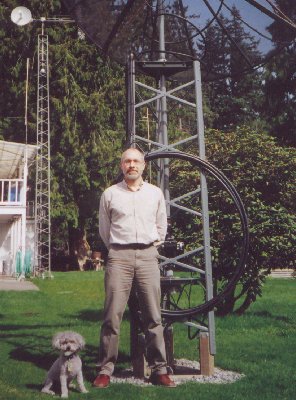
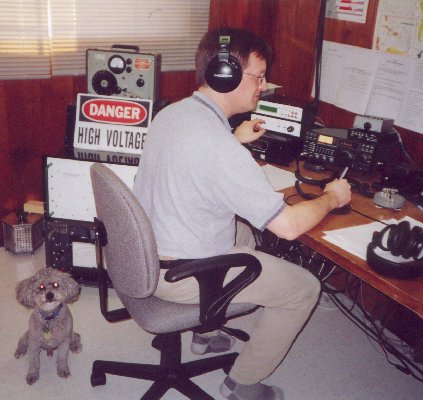
Mark
Mattila VE7CMK / VA7MM
Toby
Haynes VE7CNF
Project Moonbounce is a partnership between Mark Mattila and Toby Haynes, started in the fall of 2002 to take on the technical challenge of Earth-Moon-Earth communication. At the outset key decisions were at hand to move the project forward including the frequency band, antennas, equipment and cost. The amateur radio community was very helpful offering advice and equipment and with the purchase of a used transceiver and power amplifier for the 23cm band the project was underway. Acknowledgements to the amateur radio community include Val Lavender VE7VL, Cor Maas VE7BBG, Gunter Neugebauer VE7CLD, Lionel Edwards VE7BQH, Barry Malowanchuk VE4MA. Over the period of about a year we designed, assembled and tested the components of the 1296 MHz EME station. The first signals were received from the moon during the October 2003 ARRL EME contest. The station has been in continuous operation since and as of November 2022 the station had logged over 1700 contacts of which 323 are initials with 147 being CW/ SSB mode and 176 being digital mode. Here is an Adobe Acrobat pdf copy of our initials log as of November 2023: "VA7MM EME Initials - Call Sort" (54K).
Amateur Radio Earth-Moon-Earth Communication
EME is the art of bouncing radio signals off the moon. Scientists and the military experimented with moonbounce in the 1950's. Radio amateurs first succeeded with EME communication in 1960. Amateur EME is easier now, using a practical blend of new and old technology based on the cumulative experience of many amateurs over the years.
Amateurs attempt EME for the technical challenge. Assembling an EME station requires attention to detail, and operating EME requires patience. The signals are weak. Messages consist mostly of station call signs and signal reports in Morse code, repeated many times so that they can be heard during a moment of good signal amidst the usual fading and noise. Extended and comfortable voice conversations off the moon are done by a few amateur stations with very large antennas and high transmit power.
G4CCH (UK) recorded our signal off the moon during the November 2003 ARRL EME contest. Here is the EME Audio "G4CCH de VA7MM" (313K). Here are examples of some of the louder CW and SSB EME signals received at VA7MM:
- "DL0SHF CW 26-Oct-2013 " (1,007K)
- "DL0SHF SSB in QSO with K1RQG 15-Nov-2008 " (560K)
- "F2TU CW 5-Dec-2009 " (986K)
- "G4CCH CW 22-Oct-2011" (720K)
- "K1RQG SSB 16-Feb-2008 " (2021K)
- "K5GW CW 22-Oct-2011" (1254K)
- "PI9CAM CW 2-Apr-2017 " (596K)
- "PY2BS CW 23-Oct-2011" (878K)
- "SM4IVE CW 3-Nov-2012 " (606K)
- "W6IFE CW 23-Oct-2005 " (892K)
- "VE6TA CW 23-Oct-2011" (830K)
- "VK3UM CW 18-Oct-2008 " (480K)
- "IZ1BPN SSB 16-Feb-2013 " (1158K)
- "LZ1DB SSB 12-Mar-2016 " (883K)
- "ON7UN SSB 28-Jan-2007 " (415K)
- "W7JM CW 20-Nov-2011 " (365K)
- "DL0SHF CW 7-Nov-2017 " (1,007K)
- "CT1FGW CW 7-May-2021 " (560K)
Also hear recorded audio of a signal bounced of the International Space Station later on this page.
VA7MM 23cm EME Station
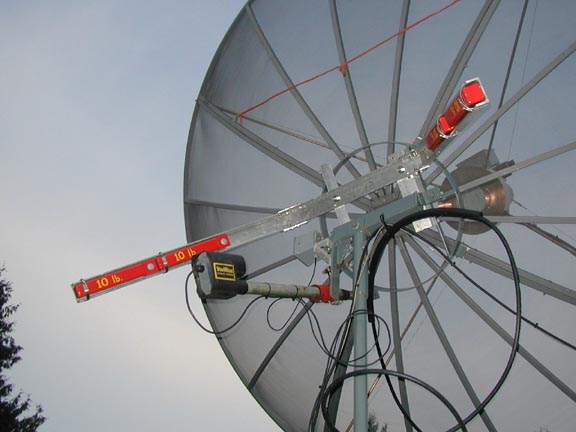
Dish from the rear
showing counterweights, altitude actuator, mount, and feed.
Antenna
- 3m (10’) TVRO Satellite Dish, aluminum frame and mesh surface, f/D= 0.375, retrofitted for EME use by VE7CMK
- Home made dual-circular polarization waveguide feed (VE4MA and W2IMU design), constructed of 0.040” and 0.025” copper sheet, by VE7CNF and VE7CMK
- Custom-modified azimuth/ elevation mount from original TVRO polar mount, motorized with azimuth motor and linear actuator by VE7CMK
- Precision potentiometers for position feedback
- Steel tower 2.4m high for antenna support with 2” steel mast, antenna mount at 4.2m above ground, installation by VE7CMK
- Three stage low noise receive amplifier, first stage WD5AGO GaAs FET mounted on the feed, second stage at feed, third stage switch selectable mounted in shack
- LDF5-50A heliax cable from the shack to the tower (courtesy of VE7CLD) and LDF4-50A heliax cable to the transmit feed probe
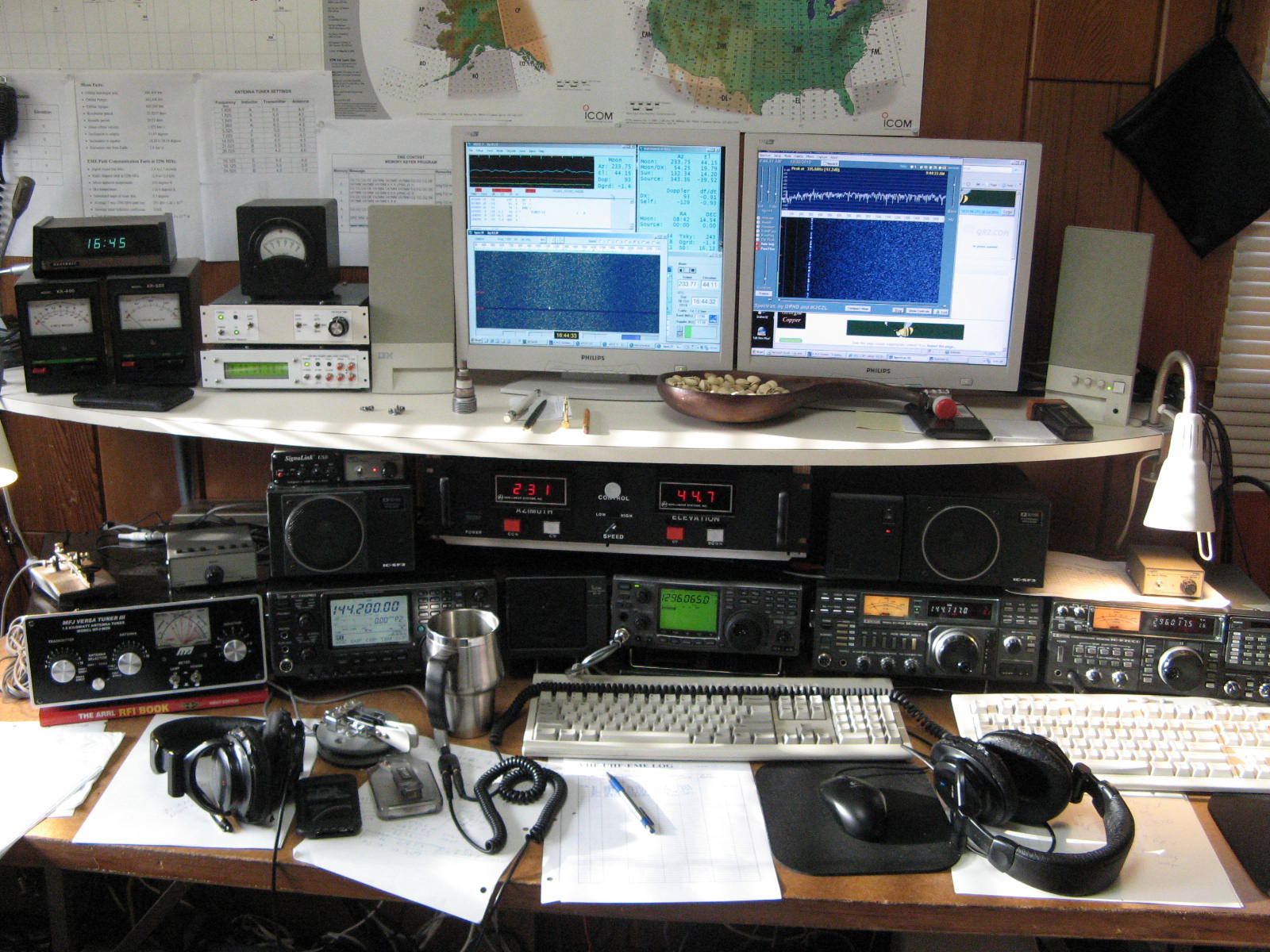
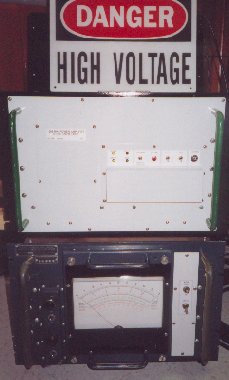
Equipment
at the operating position, and the power amplifier.
Station Equipment
- Custom built antenna controller with digital position readout and A/D interface (EA4TX design) for autotracking under computer software control, by VE7CMK
- Custom power amplifier romote control unit by VE7CNF
- Custom T/R sequencer by VE7CNF
- Icom IC910H 23cm-band transceiver
- 2.4 GHz PC for FFT spectrum analysis (Spectran software most commonly used) and moon tracking (EMESys by F1EHN software most commonly used)
- 1.8 GHz PC for JT65 digital modes (software by Joe Taylor, K1JT)
- Frequency reference crystal oven oscillator designed by VE7CNF
Power Amplifier
- 6x 7289 OZ9CR cavity and 1x 7289 coaxial driver
- 400 watts power output from amplifier for 5 watts of input drive
- Designed for remote control, internal temperature regulation, fault monitoring, tube bias regulation and metering, with self-contained water cooling system by VE7CNF
- Power supply 1350V at 1.0 amp key-down, from 220VAC line input.
Basic Station Performance
- Antenna gain: 28.4dBi calculated
- Transmit Power 200W at the dish feed after coax cable losses
- Power Amplifier Efficiency: 35%
- Transmit Power Gain: 19dB
- Sun Noise: 12dB at solar flux index 118
- T/R Relays: Latching High power N type connector
- First Stage Receive Preamp: 15dB gain, approx 0.33dB noise figure
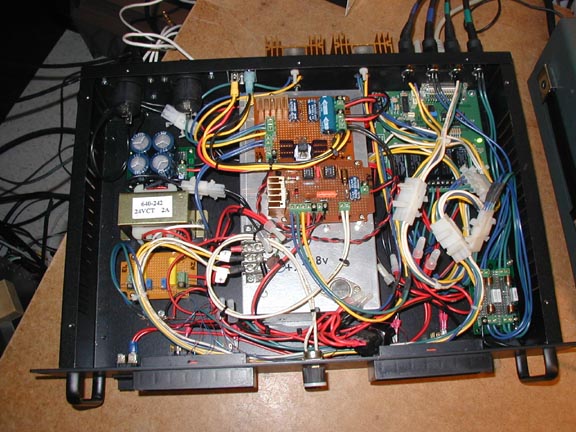
Inside the antenna position controller.

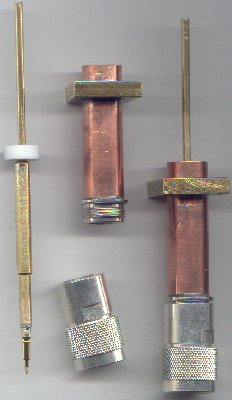
Sheet
metal and feed probe parts for our VE4MA feed antenna. Access to a friend's
lathe and vertical mill (Robert Carlson) helped a lot with this project.
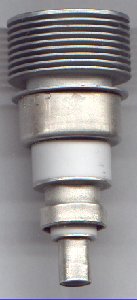
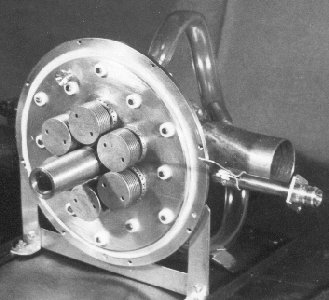
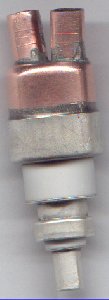
The
cavity amplifier unit design is based on a military UPX-4 pulsed L-band
transponder transmitter. It was first modified by hams for the 23-cm band in
the early 1970's. This one was built from stock brass by Hans Lohmann Rasmussen
OZ9CR. It is shown with air-cooled tubes installed (center). The 7289/3CX100A
planar triode tubes (left) have been modified for water cooling (right) in our
amplifier. The cavity unit, chassis, and HV power supply (a modified AM
modulator from an RCAF transmitter) were originally owned by VE7VL.
In a joint experiment with Cor Maas, VE7BBG (Duncan, B.C.), we used our EME stations to bounce a signal off the International Space Station on May 16, 2004, ISS Orbit 31330.
For a local high-elevation pass, both station antennas were set to auto-track along the predicted trajectory of ISS. VA7MM transmitted CW while VE7BBG listened for the signal shifted by doppler up to 60 kHz. The signal scattered off the ISS was heard for about 3 minutes.
Cor was able to hear up to a S4 on his receiver before the signal was lost. In the downloadable audio clip (below) the frequency shift in the signal is Cor's manual tuning of the signal to compensate for the changing doppler shift. The signal was lost as the ISS passed overhead and the doppler shift was too rapid to keep up with manual tuning.
Audio Recording ISS-Bounce Audio (490K)
On four subsequent ISS orbits (orbits 31438, 31469, 31562 and 31654 on May 23, May 25, May 31 and June 5, 2004 respectively) brief two way QSOs exchanging signal reports and acknowledgements were completed between VE7BBG and VA7MM by scattering signals off the ISS.
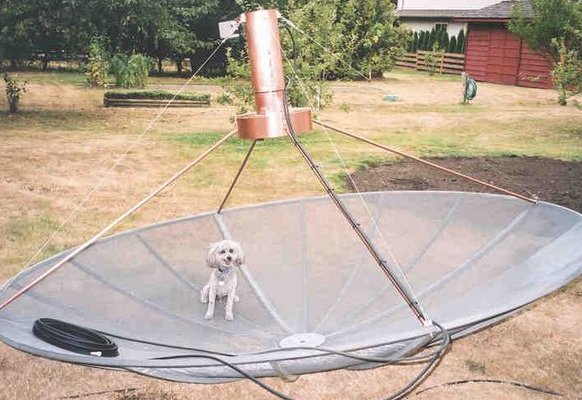
Dish
and feed before installation on the tower. Jupiter is the station mascot.